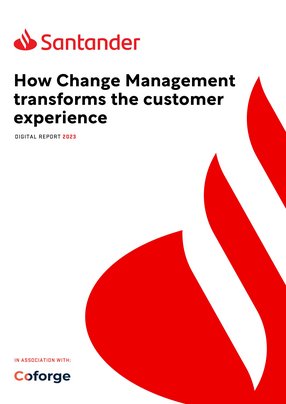How Change Management transforms the customer experience
Creating a better customer experience, generating a healthy, workplace culture, and ensuring all talent is gainfully used are challenges that can make or break a business these days.
Alongside this is the drive to take businesses – especially banks – entirely online. Branches are closing at a rate of knots, while customers are facing the prospect of their troubleshooting being carried out by increasingly sophisticated, AI-driven chatbots. Although theoretically streamlined, it cuts out the human touch – an element essential to any business that wants to garner loyalty within its customer base.
It is these elements and more that have fallen in the job jar of Santander UK’s CTO and Head of Operations, Jas Narang. A veteran of the bank with 25 years’ experience, the former engineer is a passionate advocate of healthy workplace culture and the needs of the customer. Narang is also a brilliant strategist who has led extraordinary changes within Santander UK’s digital journey. It is these changes that are leading the bank towards a unique, hybrid challenger definition that considers all the needs of its customers and staff.
Change management and a new, agile approach
Though many organisations claim to be agile and flexible, internal structures often restrict staff movement between departments. This results in the under-utilisation of talent in addition to the restriction of inter-company communication and cooperation.
To counteract this, Santander UK is employing a unique internal structure called ‘Change Management’. The system enables complete interaction and cooperation between the bank’s multiple teams, along with fluid movement between departments for staff, so that the workforce can be interoperatable and multidisciplinary. Talent isn’t static; rather, it is shared across the organisation, boosting ideas, innovation, and job satisfaction.
Workforce agility in full effect
The radical transformation of Santander UK’s internal structure began in 2020, involving 250 small to medium-sized initiatives. This makes the structure much more resilient compared with one that relies on the more usual model of, say, 10 initiatives. The idea is that the company is neither top-heavy nor bottom-heavy, but instead operates with a small, central team, surrounded by many flexible, interoperable teams.
Narang explains: “We've got a very light central team, but the involvement of a fair few hundred people across the organisation at various levels – from the front-end, customer-facing colleagues through to the C-suite. It's about cutting across the organisation and making sure that we involve as many people as possible and generate as many ideas as possible across the organisation, reimagining those processes and customer journeys.”
The benefits of such a radical approach are already evident, with faster implementation of ideas among many more innovative plans being generated across the organisation.
“Change Management has helped us to create a very strong foundation for people passionate about change, who want to make a difference to the customer and, therefore, are not only coming up with ideas, but are also being involved in the implementation of those ideas.
“That's been a cornerstone of our Change Management strategy over the last couple of years. By no means am I saying it's ultra-perfect; there's always more that you can do to get the organisation to come along the journey with you. But the idea and the strategy has been to broad base that, rather than have a small team of people who direct from the centre. It's been the key for us.”
The benefits of Change Management
While the immediate benefits of Change Management see a well-distributed and agile body of talent throughout Santander UK’s internal structure, the solution has numerous additional advantages. One of those benefits is employee inclusion in the digital transformation process. While many companies cite employee resistance to change as one of the stumbling blocks of transitioning to a digital system, Santander UK’s staff can comprehend the impact their performance has on the peripheral teams and are far more invested in driving forward the company as a whole, according to Narang.
“We set up various work streams for the transformation, involving vertical business units due to the traditional structure in a bank, but also with horizontal capabilities such as data and process re-engineering in the conversion from legacy to cloud.
“We’ve combined vertical and horizontal work streams with a work-stream leader and initiative owners with the various initiatives or projects under each of those work streams.”
The system is enormously experimental and involves more than 250 people across the organisation to physically lead each of those projects.
“Because they were leading those projects, they got intimately involved in this whole big chunk of the transformation of a programme.”
Removing roadblocks to encourage project owners to deliver their own ideas and prioritising investments and resources while having the backing of the organisation are pushing new innovations over the finish line.
“A result of that is that people have been led to participate in it – we've trained them along the way to make sure that they understand what change and transformation means. For example, over the past couple of years, we've been able to promote 27% of the people involved in transformation, compared with promotions for the entire organisation, which stand at between 12 and 13%.”
It’s a startling success story that has more than doubled the number of people involved in digital transformation, thereby maximising talent and innovation in that space. Through Change Management, staff are exposed to a wider view of their role within the bank, and this has expanded their appreciation of their impact across Santander UK.
A future that involves bank branches
Another dramatic shift that has emerged as a result of Change Management is a growth in the keen understanding of the needs of customers.
Unlike other market-leading banks, Santander UK does not have plans to close all its high-street branches. Instead, the plan is to examine customer requirements, and respond to their demands, a concept that some may see as swimming against the tide in an increasingly digitised industry – but Narang is confident in the strategy.
He explains: “Santander UK is the fifth largest bank in the country. We think of ourselves as challenging the big four of Lloyds, Barclays, HSBC, and NatWest.
“Basically, our vision and mission is to be a digital bank with a human touch. Our purpose is to help businesses and our customers prosper – that's what we exist for.”
Catering to the needs of customers
Part of this purpose is to ensure that all customer requirements are met. The bank’s recognition that, despite the widespread digitisation of the banking industry as a whole, people prefer to interact with people rather than bots is allowing Santander to set itself apart. Of course, it’s a radical move – but one that Narang takes pride in.
“During the pandemic, the banking sector saw a huge amount of change. What was going to take somewhere between 7 to 10 years – in terms of digital adoption by customers – has happened in the course of the last 18 to 24 months.
“It's a huge shift in how customers want to bank, right? Everybody wants to bank on their phone rather than walking into a branch. And that’s multiple times a day for various different requirements and needs that each customer has.
“But the reality is also that there’s a segment, or particular section of our society, that does like to walk into a branch for some specific piece of advice, or for certain types of transactions where they feel more comfortable dealing with a human-being, rather than remotely on a piece of equipment.”
The plan is for Santander UK to balance its developing digital journeys at scale, which caters to all customer’s needs. “We're aiming to be a digital bank with a human touch, or you could call it a digital bank with branches. That's what our goal is and that's what we're going to be steadfast on in the coming foreseeable future.”
Partnerships for success
To assist Santander UK in its strategies, the bank is partnered with three companies especially in the customer service and technology area, namely: Concentrix, which assists in customer journeys; Genpact for operational services; and Coforge, which handles IT fulfilment. Unlike other organisations that collaborate with a wide spectrum of businesses within the digital ecosystem, Santander UK has reformed its partnership network and chosen to form alliances with companies that can assist them across a wide range of verticals.
“Traditionally, we've had a core set of Top 20 partners, and then a very long tail that deals with hundreds of individual businesses or partners for small tasks. The endeavour today is that we're going to partner with fewer – yet more strategic – partners in the ecosystem,” says Narang.
This enables Santander UK to build deeper and more meaningful relationships with their ecosystem partners – but also strike a balance between relationship and risk: while fewer partners does mean a greater concentration of risk, this can be more than manageable with the right strategy in place.
A bright outlook for the future
As the next 18 to 24 months unfold, Narang is quietly confident about how the market will affect Santander UK. He believes a solid strategy will help the bank weather the storm. While rising inflation rates are a concern for all financial institutions, because Santander UK is a retail bank, and not an investment bank, they have not been subject to the highs and lows that other organisations are facing.
“We are largely a retail bank, not a big investment bank. Therefore, we haven't taken crazy bets on some sector A or derivative B or product C. The bulk of retail bank business is mortgages. And the reality is that when the times are tough, customers think about paying off their mortgage before a credit card or a personal loan – or any other type of borrowing. Everybody wants to protect their house first as a natural human behaviour.”
Customers deserve a flexible approach in hard times
A responsibility towards helping customers through difficult times is a priority for Santander UK. In this, personalisation is key, because economic instability requires a flexible outlook.
“You can't have a cookie-cutter approach because people deserve better. I always say, “You can stack them high and sell them cheap." Customers don't go for that any longer. That used to be the case 10 years or 15 years back, but not any more.”
His own experience as a consumer influences his take on how products and services should be managed. “I want to feel I am wanted by the bank. You're personalising stuff for me that is tailored to my needs here and now.”
Ultimately Change Management has contributed extensively to Santander UK’s agile customer experience.
Narang adds: “I'm very, very passionate about the Change Management aspect and the involvement of people. That’s the cornerstone that differentiates us from other banks or other organisations.”



